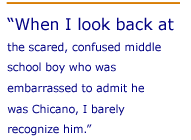
|
|
Poetry and Essays from Do Something
|
|
Proud of Both Sides
By Sami, age 13
Acceptance was easy to find,
|
Do Something is a national network of young people taking action to change their communities and the world around them. It sponsors the Kindness & Justice Challenge, a Community Connections Campaign, and the Brick Awards. Do Something’s website offers many opportunities for youth expression—from contests, polls and discussions groups to the posting of young people’s stories, essays, poetry, and artwork. www.dosomething.org |
Generation 1.5
by Suki, New York
As far as racism goes, I have been luckier than others. Sure, I happen to be an Asian female, which is not
exactly the most dissed ethnic variety, but at times is even fiercely embraced by a certain group of virile
members who can’t get past their “yellow fever.”
Even then and later through my turbulent adolescence hopping from one miserably underprivileged
inner-city New York school to another, the dark meaning of racism hardly sank into my conscience.
Perhaps I have always counted myself outside that history. After all, what do I know about the harrowingly
complex relationships between different colors within American racism? I can barely make sense of what it
means to be Korean in New York or to be a woman in a male-dominated world or to be a fiction writer amidst
the capital-frenzied careerists, never mind having to adapt to this new load of an identity called Asian American.
Each time I am faced with what I consider to be racially-motivated attitudes, I get terribly shocked, terribly
offended, terribly hurt. I throw tantrums, spit biting retorts, call friends to tell all about it. I cannot help it. I have
not yet acquired the correct or civilized disposition to cope with such heartbreaks. I am still a novice at this
touchy thing called race, and I am not convinced that I will know better any time soon.
My name is Lyn Bluehouse-Wilson. I am of the Red House Clan born of the Near the Water’s Edge
People. I am Dine from Teec Nos Pos, Arizona, in the Four Corners region of the Southwest. I am a community
organizer with the SAGE Council, formerly known as the Petroglyph National Monument Protection Coalition.
We recently changed our name to SAGE Council (Sacred Alliances for Grassroots Equality) symbolizing our
institution as a permanent People of Color-led organization. I, as the youngest of the group, have come a long way
since my beginnings as a rebellious teenage activist who grew up in a racist reservation border town. Before my
involvement with the SAGE Council, much of my activism was fueled by anger and rage. However, it was one
specific issue that opened my eyes to what I was really fighting for, and gave my fire direction. The city of Albuquerque
was buzzing about the latest controversy over the school board not allowing Native American students to wear their
traditional dress during graduation. According to the school board, it wasn’t fair for Native American students
to get special treatment. They said that all students should abide by the dress code. Civil rights lawyers countered that
the dress code had a European influence, with long black pants and knee length skirts with black shoes. They also
argued that there were special exceptions for other ethnicities and religions, but none for Native Americans.
Finally the time came to vote. Spectators sat in silence as, one by one, the board confirmed their positions. The room
filled with screams of relief and victory cries as the final vote of four to three was announced. It seemed that Albuquerque
Public Schools had finally sided with the Indians. Everyone filed outside to celebrate with the drum and get on with their
lives. For me though, it was just the beginning.
Graduation time rolled around and my mom had just finished making my Navajo dress that I would proudly
wear as I walked up to get my diploma. She told me to quickly slip it on to make sure that it fit, somehow though
I ended up in my full regalia. I think my mom had just tricked me into putting everything on so she could take pictures.
Nevertheless, I took a look in the mirror. What I saw would drastically change my way of thinking for the rest of my life.
Staring back at me was a traditional Dine woman whose dress her mother had labored for hours to create. Her father
had given her the beautiful bracelets that adorned her wrists. Her uncle had used the traditional silversmithing
methods to make her a one of a kind squash blossom necklace. Her concho belt was the one her grandfather had
used to buy his very first head of cattle. An aunt contributed the sash that was tightly wrapped around her waist.
She would walk into a new chapter of her life wearing the moccasins that were meant to fit only her. In that instant I
suddenly remembered what the final vote really was. The school board had voted 4 to 3 to allow Native students
to wear traditional outfits, but they were required to also wear their caps and gowns. In other words, Albuquerque
Public Schools wanted to cover up something that my ancestors had fought and died to preserve with
a thirty-dollar mass-produced polyester-cloth.
Just as they did drugs to block out reality, I blocked out reality with such heavy doses of undirected anger
and rage that I had forgotten what I was really fighting for. Only when I looked in the mirror as who I really was
and remembered where I really came from, did I realize that it had taken a strong community, my family, to come
together and help me graduate as a proud Native American woman.
They were the reason why I didn’t do drugs, they were the reason why I was college-bound, they were
the reason why I was a leader. It was that understanding of my accountability to my ancestors that has defined
my vision as a community organizer. It has helped me clearly see that a solid foundation is the most powerful
vehicle to build a strong community.
A strong community cannot be built on anger and rage. It must be built on respect and love. This is what I
carry with me as I continue my work with SAGE Council, for my elders, for my peers, and for my children.
And it was with respect, humility and dignity that my fellow students and I removed our gowns on graduation day.
My Mom, Sara, and Dad, Guadalupe, were born in Zacatecas, Mexico. Along with my sister, Mirna, and my
two brothers, Alex and Adrian, I was born in the United States. We are the first generation of our family born in the
United States. Our parents cannot read or speak English.
Like any child, I wanted to go outside to play, but I knew it was too dangerous. Ever since I was a small child I
wanted to move away from the neighborhood. But we couldn’t afford to move.
My stepbrother, who’s ten years older than me, lived with us. He was a former gang member and
spent time in and out of jail. I didn’t see him very much, but when he was home he treated me very
badly. He called me names and said hurtful things to me.
As I got older, things got worse. I was ashamed of my parents because of their background. I cried all the time,
wishing that my parents could speak my language. I was in middle school and I wanted to be like the other kids
with their parents who spoke English, participated in school activities, and did things together as a family.
I started to claim I was half-Italian and half-Mexican. My sister found out and lectured me about my pride. She
told me I should be proud of all of the struggles our parents went through for us. At the time though, all I wanted was
to feel like I belonged. I knew I didn’t want to join a gang. After experiencing the pain my stepbrother brought
to my parents and me, I vowed to myself, no matter how I lonely I felt, that I would find acceptance in a positive way.
I couldn’t believe what I was hearing. I had wanted to find a positive direction in my life. I had wanted to
feel like I belonged somewhere, and suddenly here was a group for me. This was like a dream coming true!
When we went to the universities, the Chicano students told us we should be the best we can be. We attended
workshops motivating us, as first-generation kids, to go to college.
I started going to all of the M.E.Ch.A meetings. Latino or Chicano speakers came to discuss their occupations.
A lady named Diana Perez, a city employee from the Department of Health and Human Services of Long Beach,
told us about a program she had just started. This program, called S.T.A.R.S. (Students Talking About Resisting
Substances), needed volunteers to become peer educators to help teach middle school youth about drugs and
alcohol. I immediately volunteered. I was trained and after a year I wasn’t a volunteer anymore because I was hired part-time!
The following year, as a tenth grader, I became president of M.E.Ch.A. Diana Bernal introduced me to
a teacher at a school named Ms. Hernandez. Ms. Hernandez wanted me to know about a youth program
called Youth Leadership Long Beach (YLLB). This program was a program for the youth in the city of Long
Beach to help develop leadership skills. I applied. Only thirty students were chosen, and I was one of them.
Before I could graduate I had to complete a project. Our group chose to conduct a teen forum, to help
make the youth of Long Beach aware of organizations that they could get involved in. I was excited about
the project because I knew how life-changing good information could be.
We passed out flyers, called people, and got donations for the food for the guests and the youth at the
forum. Lots of students came. Watching them sign up to join different organizations made me wonder if perhaps
any of them were feeling like I used to. Maybe I had given him or her the gift my cousin had given me — an awareness of a new direction in life. If so, I would consider the forum to be a huge success.
Eleventh grade was the best year of my life. I got my driver’s license, bought my own car, and met my
first girlfriend. I worked for the Long Beach Department of Health and Human Services facilitating an HIV/AIDS
prevention program called TLC-Teens Living Carefully. It was a four-session class teaching youth about HIV
transmission, setting limits in a sexual relationship, condom negotiations, and decision-making skills.
This year, my senior year, I am associated student body president of my school. I had to campaign for the
position and I won. I oversee the freshman, sophomore, junior, and senior classes and their class officers.
When I look back at the scared, confused middle school boy who was embarrassed to admit he was Chicano,
I barely recognize him. When I’m working with teens who are looking for direction in their lives, I always say
to them, “Get involved. Join a club or join an organization that interests you. Don’t let anything or
anyone stop you from believing in yourself. The only way for you to believe in others and make our world a better
place is for you to first believe in you. Today really can be the first day of the rest of your life.” 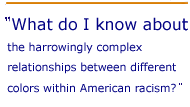 The blessing, as I consider now, is that I did not grow up with its chilling and disheartening reality. I belong
to that lucky breed of “Generation 1.5”— the kids who have followed their parents on the
immigrant odyssey often fully-grown and fluent in their native language. I grew up in Seoul, South Korea,
and was not even aware of what “Asianness” might be until I landed at the vast wasteland of
JFK airport at the age of thirteen and looked around its melting gates and terminals and noticed that others
simply looked either darker or lighter than me.
The blessing, as I consider now, is that I did not grow up with its chilling and disheartening reality. I belong
to that lucky breed of “Generation 1.5”— the kids who have followed their parents on the
immigrant odyssey often fully-grown and fluent in their native language. I grew up in Seoul, South Korea,
and was not even aware of what “Asianness” might be until I landed at the vast wasteland of
JFK airport at the age of thirteen and looked around its melting gates and terminals and noticed that others
simply looked either darker or lighter than me.
Preserving My Native American Culture on Graduation Day
by Lyn, age 19, New Mexico 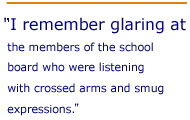 We formed in 1996 to protect the sacred rock etchings known as the Petroglyph National Monument on the
Westside of our city from a six-lane commuter highway. The Petroglyphs are used by the Pueblos and other
tribes in this area for religious purposes and are considered a sacred sight by many other indigenous peoples.
In the four years since we formed, we have successfully brought national attention to this issue of Religious Freedom
while establishing ourselves as an accountable voice for our community.
We formed in 1996 to protect the sacred rock etchings known as the Petroglyph National Monument on the
Westside of our city from a six-lane commuter highway. The Petroglyphs are used by the Pueblos and other
tribes in this area for religious purposes and are considered a sacred sight by many other indigenous peoples.
In the four years since we formed, we have successfully brought national attention to this issue of Religious Freedom
while establishing ourselves as an accountable voice for our community. 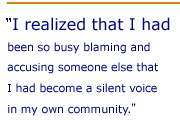 The local newspapers and television stations flooded the school board chambers the night the issue was to be heard.
Young people dressed in their traditional regalia emotionally took the podium, while elders looked on and the small
ones squirmed impatiently in their seats. I remember sitting there and glaring at the members of the school board who
were listening to testimony after testimony with crossed arms and smug expressions.
The local newspapers and television stations flooded the school board chambers the night the issue was to be heard.
Young people dressed in their traditional regalia emotionally took the podium, while elders looked on and the small
ones squirmed impatiently in their seats. I remember sitting there and glaring at the members of the school board who
were listening to testimony after testimony with crossed arms and smug expressions. 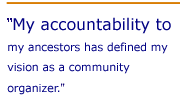 Suddenly I realized that I had been so busy blaming and accusing someone else that I had become a silent
voice in my own community not realizing that the cloth had once again been pulled over my eyes. Instead of acknowledging
that my peers went home to abuse, poverty and alcoholism everyday, I blamed the system for their problems and never really took any solid action.
Suddenly I realized that I had been so busy blaming and accusing someone else that I had become a silent
voice in my own community not realizing that the cloth had once again been pulled over my eyes. Instead of acknowledging
that my peers went home to abuse, poverty and alcoholism everyday, I blamed the system for their problems and never really took any solid action.
Believe In Who You Are
by Mario, California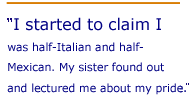 We live in the lower west side of Long Beach, California. Our family has lived here for twenty years. This
is a low-income, dangerous neighborhood. It has a pretty bad reputation from gang warfare. I used to crawl
into my mother’s room every time I heard gunshots. I never knew if a bullet was going to come through our window.
We live in the lower west side of Long Beach, California. Our family has lived here for twenty years. This
is a low-income, dangerous neighborhood. It has a pretty bad reputation from gang warfare. I used to crawl
into my mother’s room every time I heard gunshots. I never knew if a bullet was going to come through our window. 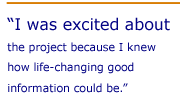 Then my cousin Dorina happened to invite me to a meeting of an organization she was in at school called M.E.Ch.A
(Movimiento Estudiantil Chicanos de Aztlan). The president of the club, Diana Bernal, announced three upcoming
events she wanted everyone to attend. She said that they would motivate us and make us proud of our struggles
as a race. We would be going to UCLA (University of California - Los Angeles), USC (University of Southern California),
and California State University at Long Beach to visit the universities and meet with Chicanos attending those schools.
She reminded us of the philosophy of the club, that political involvement and education were the best avenues for change in Chicano society.
Then my cousin Dorina happened to invite me to a meeting of an organization she was in at school called M.E.Ch.A
(Movimiento Estudiantil Chicanos de Aztlan). The president of the club, Diana Bernal, announced three upcoming
events she wanted everyone to attend. She said that they would motivate us and make us proud of our struggles
as a race. We would be going to UCLA (University of California - Los Angeles), USC (University of Southern California),
and California State University at Long Beach to visit the universities and meet with Chicanos attending those schools.
She reminded us of the philosophy of the club, that political involvement and education were the best avenues for change in Chicano society.
